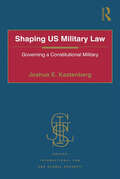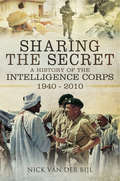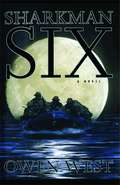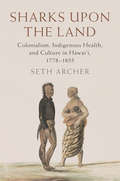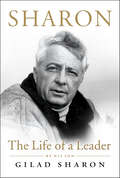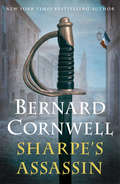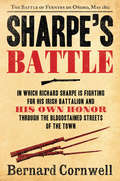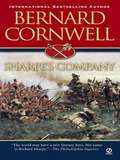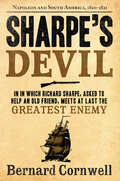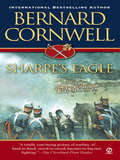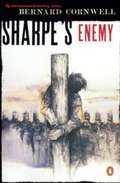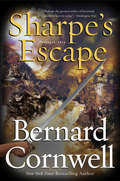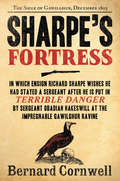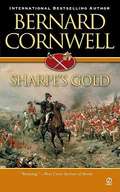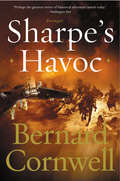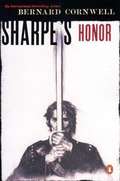- Table View
- List View
Shaping British Foreign and Defence Policy in the Twentieth Century: A Tough Ask in Turbulent Times (Security, Conflict and Cooperation in the Contemporary World)
by Malcolm H. MurfettThis volume is devoted to the shaping of British foreign and defence policymaking in the twentieth century and illustrates why it's relatively easy for states to lose their way as they grope for a safe passage forward when confronted by mounting international crises and the antics of a few desperate men.
Shaping US Military Law: Governing a Constitutional Military
by Joshua E. KastenbergSince the United States’ entry into World War II, the federal judiciary has taken a prominent role in the shaping of the nation’s military laws. Yet, a majority of the academic legal community studying the relationship between the Court and the military establishment argues otherwise providing the basis for a further argument that the legal construct of the military establishment is constitutionally questionable. Centering on the Cold War era from 1968 onward, this book weaves judicial biography and a historic methodology based on primary source materials into its analysis and reviews several military law judicial decisions ignored by other studies. This book is not designed only for legal scholars. Its intended audience consists of Cold War, military, and political historians, as well as political scientists, and, military and national security policy makers. Although the book’s conclusions are likely to be favored by the military establishment, the purpose of this book is to accurately analyze the intersection of the later twentieth century’s American military, political, social, and cultural history and the operation of the nation’s armed forces from a judicial vantage.
Shards: A Novel
by Ismet PrcicA New York Times Notable Book: &“Brilliant . . . With verbal glee, Prcic serves up a darkly comic vision of the terrors and misunderstandings of immigration&” (Shelf Awareness). Ismet Prcic&’s brilliant, provocative, and energetic debut novel is about a young Bosnian, also named Ismet Prcic, who has fled his war-torn homeland and is now struggling to reconcile his past with his present life in California. He is advised that in order to make peace with the corrosive guilt he harbors over leaving his family behind, he must &“write everything.&” The result is a great rattlebag of memories, confessions, and fictions: sweetly humorous recollections of Ismet&’s childhood in Tuzla appear alongside anguished letters to his mother about the challenges of life in this new world. As Ismet&’s foothold in the present falls away, his writings are further complicated by stories from the point of view of another young man—real or imagined—named Mustafa, who joined a troop of elite soldiers and stayed in Bosnia to fight. When Mustafa&’s story begins to overshadow Ismet&’s new-world identity, the reader is charged with piecing together the fragments of a life that has become eerily unrecognizable, even to the one living it. Shards is a thrilling read—a harrowing war story, a stunningly inventive coming of age, and a heartbreaking saga of a splintered family. &“Fierce, funny and real, it also says much about war, exile, guilt and fear.&” —Chicago Sun-Times, Favorite Books of 2011
Sharing the Secret: The History of the Intelligence Corps 1940–2010
by Nicholas van der BijlWhile written under the auspices of the Trustees of the Military Intelligence Museum, Sharing the Secret is not an academic regimental history. Rather it gives a privileged glimpse into a necessarily publicity-shy organization that has been deeply involved in military intelligence operations since its inception in 1940 through to 2010. Understandably, little has been written about the Corps' work for Official Secret reasons.The development of Field Security and Protective Security and measures taken to protect the Army for espionage, sabotage, subversion and terrorism in peace and war are examined. These tasks were particularly important during the de-Nazification of Germany during the aftermath of the Second World War. Field Security led to the successful arrest of leading Nazis, including Himmler and Doenitz.The author, who served in the Corps for over 20 years and saw active service in Northern Ireland and the Falklands, gives fascinating examples of differing Intelligence techniques in action. These include the exploitation of Imagery Interpretation, Human Intelligence, including the interrogation of prisoners of war, the examination of enemy documents and the deployment of Signals Intelligence so that commanders have enough information to fight the battles. The support the Intelligence Corps gave to the Special Operations Executive during the Second World War is well covered, as are examples of Special Duties since 1945.The reader will appreciate that, as with any work relating to national intelligence and security, Sharing the Secret has been written under the restrictions of the era. That said, it provides a long-overdue insight into the contribution of members of the Intelligence Corps over seventy years of war and peace.As featured in Burnham & Highbridge News
Sharkman Six
by Owen WestWhen Lieutenant Gavin Kelly's recon platoon swims ashore a Mogadishu beach under the glare of hundreds of news camera lights, it is an appropriately surreal beginning to Operation Restore Hope. This modern war is vastly different from the battles Kelly's father and grandfather fought and from the young lieutenant's own experience during Operation Desert Storm. Minutes after the Marines' celebrated landing, one of Kelly's men kills an armed Somali bodyguard. The circumstances of the killing are unclear and Kelly finds himself in the center of a maelstrom. He must act quickly to deflect a vociferous outcry from members of the international press corps, censure by his Marine superiors, and the possibility of losing the loyalty of his men -- particularly two enlisted leaders in the platoon who have vouched for the necessity of the kill. Thus begins Sharkman Six, a stinging morality tale in which Kelly is torn between his men, his confusing mission, and the international rules of engagement he has sworn to uphold. As his platoon descends into the lawless, violent underbelly of Somalia, Lieutenant Kelly must determine his own values -- and allegiances -- in a country where murders are commonplace and constant. With heart-pounding, intricate military detail, rapier wit, and stunning verisimilitude, Sharkman Six speaks to the violent urges lurking in us all and the lengths to which we will go to control them. In Gavin Kelly, West has created an authentic, sympathetic, and wholly compromised young officer of war who will put you in mind of the best of military heroes and antiheroes.
Sharks Upon the Land: Colonialism, Indigenous Health, and Culture in Hawai'i, 1778-1855 (Studies In North American Indian History )
by Seth ArcherHistorian Seth Archer traces the cultural impact of disease and health problems in the Hawaiian Islands from the arrival of Europeans to 1855. Colonialism in Hawaiʻi began with epidemiological incursions, and Archer argues that health remained the national crisis of the islands for more than a century. Introduced diseases resulted in reduced life spans, rising infertility and infant mortality, and persistent poor health for generations of Islanders, leaving a deep imprint on Hawaiian culture and national consciousness. Scholars have noted the role of epidemics in the depopulation of Hawaiʻi and broader Oceania, yet few have considered the interplay between colonialism, health, and culture – including Native religion, medicine, and gender. This study emphasizes Islanders’ own ideas about, and responses to, health challenges on the local level. Ultimately, Hawaiʻi provides a case study for health and culture change among Indigenous populations across the Americas and the Pacific.
Sharon Sala Thrillers: The Chosen, Missing, Sweet Baby, The Perfect Lie
by Sharon SalaFour romantic thrillers from the New York Times–bestselling author of the Jigsaw Files novels.The Chosen Reporter January De Lena believes the recent murders of homeless men in Washington, D.C., are all connected to a madman who calls himself &“The Sinner.&” In order to track him down, she teams up with homicide detective Benjamin North, but it will take more than a handsome cop to protect her when she finds herself in the killer&’s path . . .Missing When Wes, a former POW struggling with PTSD, meets Ally in the mountains of West Virginia, it brings him back to life. But a neighbor is hiding a secret operation, and he&’ll stop at nothing to keep Wes and Ally out of it—and to take Ally for his own.Sweet Baby Abandoned as a child and bounced from foster home to foster home, photojournalist Tory Lancaster has finally found someone to love in Brett Hooker, an investigator for the Oklahoma County DA&’s Office. When a face from her past triggers a wave of unfamiliar memories, she&’ll need Brett&’s help if she hopes to learn the truth . . .The Perfect Lie CIA agent Jonah Slade has returned from undercover work in the jungles of South America to discover that his former lover has been killed in cold blood, her fifteen year-old-son has been kidnapped, and it&’s all tied to his very dangerous line of work. To save the boy, he must face his past sins—and the woman he let get away.
Sharon: The Life of a Leader
by Gilad SharonDrawn from extensive personal archives and filled withstartling revelations, the definitive biography of Ariel Sharon illuminates hislife and work from the penetrating perspective of his youngest son, Gilad Sharon—one of his father’s closest confidants.Readers of George W. Bush’s Decision Points, Tony Blair’s A Journey,Yitzhak Rabin’s The Rabin Memoirs, and Moshe Dayan’s Story of My Life,as well as Benjamin Netanyahu’s A Durable Peace, will be fascinated by Gilad Sharon’s piercing, authoritative, and intimateportrait of Ariel Sharon the Prime Minister, the father, and the military hero,in a narrative that traces his evolution into a powerful and influential forceat the center of Middle Eastern and world politics.
Sharpe's Assassin: Richard Sharpe and the Occupation of Paris, 1815 (Sharpe #22)
by Bernard CornwellNew York Times bestselling author Bernard Cornwell returns with his iconic hero, Richard Sharpe.SHARPE IS BACK.Outsider.Hero.Rogue.And the one man you want on your side.Sharpe's Assassin is the brand-new novel in the bestselling historical series that has sold more than twenty million copies worldwide.
Sharpe's Battle: The Battle of Fuentes de Onoro, May 1811 (Sharpe #12)
by Bernard CornwellFrom New York Times bestselling author Bernard Cornwell, the twelth installment in the world-renowned Sharpe series, chronicling the rise of Richard Sharpe, a Private in His Majesty’s Army at the siege of Seringapatam. Quartered in a crumbling Portuguese fort, Richard Sharpe and his men are attacked by an elite French unit, led by an old enemy of Sharpe’s, and suffer heavy losses.The army’s high command blame Sharpe for the disaster and his military career seems to be ruined. His only hope is to redeem himself on the battlefield. So with his honour at stake, against an overwhelming number of French troops, Sharpe leads his men to battle in the narrow streets of Fuentes de Oñoro.
Sharpe's Command: Richard Sharpe and the Bridge at Almaraz, May 1812 (Sharpe #14)
by Bernard CornwellNew York Times bestselling author Bernard Cornwell returns to the early years of the nineteenth century, capturing the bravery, battles, and bloodshed of Britain’s peninsular wars with this epic tale featuring his iconic hero Richard Sharpe.Outsider.Hero.Rogue.If any man can do the impossible it’s Richard Sharpe.And the impossible is exactly what the formidable Captain Sharpe is asked to do when he’s sent on an undercover mission to a small village in the Spanish countryside, far behind enemy lines.For the quiet, remote village, sitting high above the Almaraz bridge, is about to become the center of a battle for the future of Europe. Two French armies march towards the bridge, one from the North and one from the South. If they meet, the British are lost.Only Sharpe's small group of men—with their cunning and courage to rely on—stand in their way. But they're rapidly outnumbered, enemies are hiding in plain sight, and as the French edge ever closer to the frontline, time is running out. . . .
Sharpe's Company
by Bernard CornwellTo stem the Napoleonic tide, Sharpe must capture a fortress--where his wife and infant daughter are trapped--while protecting himself from a fellow officer determined to destroy him.
Sharpe's Company: Richard Sharpe and the Siege of Badajoz, January to April 1812 (Richard Sharpe #13)
by Bernard CornwellTHE BRITISH MUST MOUNT A BLOODY ATTACK THAT NO MAN COULD SURVIVE--NO MAN EXCEPT CAPTAIN RICHARD SHARPE. Looming on the border of Portugal and Spain is the fortress of Badajoz. To lead an assault on its thick, sheer walls and battlements is suicide, yet Richard Sharpe must lead one. Inside the walls are his wife and daughter, and only he can save them. Outside is the misshapen, vengeance-crazed Sergeant Obadiah Hakeswill, a man determined to kill Sharpe. Sharpe knows that in the heat of battle only the cold steel of his battered sword and the ruthless bloodlust of a soldier at war will protect him from the danger of both sides.
Sharpe's Devil: Napoleon and South America, 1820-1821 (Sharpe #23)
by Bernard CornwellFrom New York Times bestselling author Bernard Cornwell, another exciting adventure in the world-renowned Sharpe series, chronicling the rise of Richard Sharpe, a Private in His Majesty’s Army at the siege of Seringapatam. Five years after the Battle of Waterloo, Sharpe’s peaceful retirement in Normandy is shattered. An old friend, Don Blas Vivar, is missing in Chile, reported dead at rebel hands – a report his wife refuses to believe. She appeals to Sharpe to find out the truth.Sharpe, along with Patrick Harper, find themselves bound for Chile via St. Helena, where they have a fateful meeting with the fallen Emperor Napoleon. Convinced that they are on their way to collect a corpse, neither man can imagine that dangers that await them in Chile…
Sharpe's Eagle: Richard Sharpe And The Talavera Campaign, July 1809 (Richard Sharpe Adventure Ser. #No. 8)
by Bernard CornwellAfter the cowardly incompetence of two officers besmirches their name, Captain Richard Sharpe must redeem the regiment by capturing the most valued prize in the French Army--a golden Imperial Eagle, the standard touched by the hand of Napoleon himself.
Sharpe's Enemy
by Bernard CornwellA band of renegades led by Sharpe's vicious enemy, Obadiah Hakeswill, holds a group of British and French women hostage on a strategic mountain pass. Outnumbered and attacked from two sides, Sharpe must hold his ground or die in the attempt.
Sharpe's Enemy: Richard Sharpe and the Defence of Portugal, Christmas 1812 (Richard Sharpe's Adventure Series #16)
by Bernard CornwellRenegades occupy a village and kidnap some women. Sharpe must face his old enemy Obadiah Hakeswill in order to rescue the hostages.
Sharpe's Escape: The Bussaco Campaign, 1810 (Sharpe #10)
by Bernard CornwellFrom New York Times bestselling author Bernard Cornwell, the tenth installment in the world-renowned Sharpe series, chronicling the rise of Richard Sharpe, a Private in His Majesty’s Army at the siege of Seringapatam. Sharpe’s job as Captain of the Light Company is under threat and he has made a new enemy, a Portuguese criminal known as Ferragus. Discarded by his regiment, Sharpe wages a private war against Ferragus – a war fought through the burning, pillaged streets of Coimbra, Portugal’s ancient university city.Sharpe’s Escape begins on the great, gaunt ridge of Bussaco where a joint British and Portuguese army meets the overwhelming strength of Marshall Massena’s crack troops. It finishes at Torres Vedras where the French hopes of occupying Portugal quickly die.
Sharpe's Fortress: Richard Sharpe and the Siege of Gawilghur, December 1803 (Sharpe #3)
by Bernard Cornwell"The greatest writer of historical adventures today." —Washington PostCritically acclaimed, perennial New York Times bestselling author Bernard Cornwell (Agincourt, The Fort, the Saxon Tales) makes real history come alive in his breathtaking historical fiction. Praised as "the direct heir to Patrick O'Brian" (Agincourt, The Fort), Cornwell has brilliantly captured the fury, chaos, and excitement of battle as few writers have ever done—perhaps most vividly in his phenomenally popular novels following the illustrious military career of British Army officer Richard Sharpe during the late 18th and early 19th centuries. In Sharpe's Fortress, Ensign Sharpe's adventures in India reach a grand finale at the Siege of Gawilghur during the Maharatta War in December 1803, as Cornwell's hero uncovers a foul treason and seeks a righteous revenge. Perhaps the San Francisco Chronicle said it best: "If only all history lessons could be as vibrant."
Sharpe's Fury: Richard Sharpe and the Battle of Barrosa, March 1811 (Sharpe #11)
by Bernard CornwellFrom New York Times bestselling author Bernard Cornwell, the eleventh installment in the world-renowned Sharpe series, chronicling the rise of Richard Sharpe, a Private in His Majesty’s Army at the siege of Seringapatam. In the winter of 1811, the war seems lost. Spain has fallen to the French, except for Cadiz, now the Spanish capital and itself under siege. Inside the city walls an intricate diplomatic dance is taking place and Richard Sharpe faces more than one enemy.The small British force is trapped by a French army, and their only hope lies with the outnumbered redcoats outside refusing to admit defeat. There, in the sweltering horror of Barrosa, Sharpe will meet his old enemy Colonel Vandal once again.
Sharpe's Gold
by Bernard CornwellWith Wellington outnumbered, the bankrupt army's only hope of avoiding, collapse is a hidden cache of Portuguese gold. Only Captain Richard Sharpe is capable of stealing it--and it means turning against his own men.
Sharpe's Gold
by Bernard CornwellWith Wellington outnumbered, the bankrupt army's only hope of avoiding, collapse is a hidden cache of Portuguese gold. Only Captain Richard Sharpe is capable of stealing it—and it means turning against his own men.
Sharpe's Gold: Richard Sharpe and the Destruction of Almeida, August 1810 (Richard Sharpe #9)
by Bernard CornwellWELLINGTON MUST CALL ON THE ONLY MAN BRAVE AND RUTHLESS ENOUGH TO WIN AT ANY COST--CAPTAIN RICHARD SHARPE A year after the victory at Talavera, Wellington's army, outnumbered and bankrupt, is on the verge of collapse. Its only hope lies in a cache of gold hidden in the Portuguese mountains, and the only man capable of stealing it is Captain Richard Sharps. He embarks on a secret mission that pits him against the French army; El Católico, the fanatical Spanish guerrilla leader; and El Católico's lover, the beautiful but deadly Teresa. A series of battles lead him through Portugal to the fortress of Almeida, where he is trapped. But Sharpe is determined to succeed--even if it means turning against his own side.
Sharpe's Havoc: Richard Sharpe and the Campaign in Northern Portugal, Spring 1809 (Sharpe #7)
by Bernard CornwellNew York Times Bestselling AuthorNewly ReissuedRichard Sharpe returns to the battlefields of the Iberian Peninsula, where he and his men bravely fight the French invasion into Portugal in 1809. The world-renowned Sharpe series is now available with gorgeous packaging for a new generation of readers A few years after Richard Sharpe’s heroic exploits on the battlefields of Trafalgar, Sharpe finds himself once again in Portugal, fighting the savage armies of Napoleon Bonaparte, as they try to bring the whole of the Iberian Peninsula under their control. Travelling with a small British contingent, Sharpe is on the lookout for Kate Savage, the daughter of an English wine shipper, who has gone missing a few months before. But just as he follows the first leads to the missing girl, the French onslaught on Portugal begins and the city of Oporto becomes a bloody scene of carnage and disaster as it falls into the hands of the enemy.
Sharpe's Honor
by Bernard CornwellAn unfinished duel, a midnight murder, and the treachery of a beautiful prostitute lead to the imprisonment of Sharpe. <P><P>Caught in a web of political intrigue for which his military experience has left him fatally unprepared, Sharpe becomes a fugitive--a man hunted by both ally and enemy alike.

